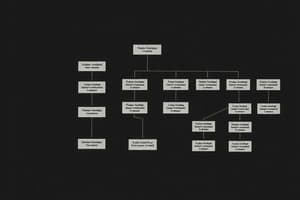Podcast
Questions and Answers
What is the primary purpose of UML diagrams in system design?
What is the primary purpose of UML diagrams in system design?
To provide a visual representation of system architecture and design.
How do aggregation and composition differ in class relationships?
How do aggregation and composition differ in class relationships?
Aggregation allows parts to exist independently of the whole, while composition does not.
Identify two key considerations in system design and explain their importance.
Identify two key considerations in system design and explain their importance.
Scalability and security. Scalability ensures the system can grow, while security protects against unauthorized access.
What does the term 'polymorphism' refer to in object-oriented programming?
What does the term 'polymorphism' refer to in object-oriented programming?
What is the purpose of use case diagrams in the context of UML?
What is the purpose of use case diagrams in the context of UML?
Describe one technique used in requirements gathering and its advantages.
Describe one technique used in requirements gathering and its advantages.
Explain the concept of 'inheritance' in class relationships.
Explain the concept of 'inheritance' in class relationships.
What is an activity diagram, and how does it support system design?
What is an activity diagram, and how does it support system design?
Flashcards are hidden until you start studying
Study Notes
Object Oriented Analysis
UML Diagrams
- Purpose: Visual representation of system architecture and design.
- Types of UML Diagrams:
- Use Case Diagrams: Illustrate user interactions with the system.
- Class Diagrams: Show classes, attributes, methods, and relationships.
- Sequence Diagrams: Detail interactions between objects over time.
- Activity Diagrams: Represent workflows and processes.
- State Diagrams: Demonstrate states and transitions of objects.
System Design
- Definition: The process of defining the architecture, components, modules, interfaces, and data for a system.
- Key Considerations:
- Modularity: Breaking down the system into manageable pieces.
- Scalability: Designing for future growth and changes.
- Performance: Ensuring the system meets speed and efficiency requirements.
- Security: Incorporating safeguards against unauthorized access and data breaches.
Class Relationships
- Types of Relationships:
- Association: A general connection between classes (e.g., one-to-many).
- Aggregation: A whole-part relationship where a part can exist independently (e.g., a school and its students).
- Composition: A stronger whole-part relationship where parts cannot exist independently (e.g., a house and its rooms).
- Inheritance: Mechanism where a new class (subclass) inherits attributes and behaviors from an existing class (superclass).
- Polymorphism: Ability for different classes to be treated as instances of the same class through a common interface.
Requirements Gathering
- Definition: The process of collecting the needs and expectations of users and stakeholders.
- Techniques:
- Interviews: Direct discussions with stakeholders to understand their needs.
- Surveys/Questionnaires: Collecting data from a larger audience.
- Workshops: Collaborative sessions to define requirements.
- Prototyping: Creating mockups to visualize requirements.
- Document Analysis: Reviewing existing documentation for insights.
Design Patterns
- Definition: Reusable solutions to common design problems in software development.
- Categories:
- Creational Patterns: Deal with object creation mechanisms (e.g., Singleton, Factory).
- Structural Patterns: Focus on class and object composition (e.g., Adapter, Composite).
- Behavioral Patterns: Concerned with object interaction and responsibility (e.g., Observer, Strategy).
- Benefits:
- Improves code maintainability and readability.
- Enhances collaboration by providing a common language for developers.
- Facilitates design reuse and reduces development time.
UML Diagrams
- Visual tools for depicting system architecture and design.
- Use Case Diagrams: Show user-system interactions and functional requirements.
- Class Diagrams: Depict classes along with their attributes, methods, and relationships.
- Sequence Diagrams: Illustrate the order of messages exchanged between objects over specific time frames.
- Activity Diagrams: Represent the flow of control or data within processes and workflows.
- State Diagrams: Model the various states of an object and the transitions between those states.
System Design
- Involves specifying the architecture, components, modules, interfaces, and data flow for a software system.
- Modularity: Creates manageable segments within the system for easier development.
- Scalability: Ensures the system can accommodate future growth without major changes.
- Performance: Focuses on achieving required speed and efficiency targets for the application.
- Security: Integrates measures to protect the system from unauthorized access and data breaches.
Class Relationships
- Describes how classes interact and relate to one another.
- Association: Indicates a general relationship where objects can exist independently (e.g., one-to-many relationships).
- Aggregation: Denotes a whole-part relationship that allows parts to exist separately (e.g., a university and its students).
- Composition: Represents a stronger dependency where parts cannot exist independently of the whole (e.g., a car and its wheels).
- Inheritance: Enables a subclass to derive properties and methods from a superclass, promoting code reusability.
- Polymorphism: Allows objects of different classes to be treated as instances of a common superclass, enhancing flexibility.
Requirements Gathering
- The systematic process for capturing the needs and desires of users and stakeholders.
- Interviews: In-depth discussions with stakeholders to gather qualitative insights.
- Surveys/Questionnaires: Methods to collect quantitative data from a broader audience.
- Workshops: Group sessions fostering collaboration to define and refine requirements.
- Prototyping: The process of building mockups to visualize and adjust requirements effectively.
- Document Analysis: Involves reviewing existing documentation for extracting relevant information and insights.
Design Patterns
- Established solutions to frequently occurring design problems in software engineering.
- Creational Patterns: Address issues related to object instantiation (e.g., Singleton, Factory methods).
- Structural Patterns: Focus on how classes and objects are composed (e.g., Adapter, Composite patterns).
- Behavioral Patterns: Concern the responsibilities and communication between objects (e.g., Observer, Strategy patterns).
- Benefits: Enhance code maintainability, facilitate collaboration, and promote design reuse which can reduce overall development time.
Studying That Suits You
Use AI to generate personalized quizzes and flashcards to suit your learning preferences.




